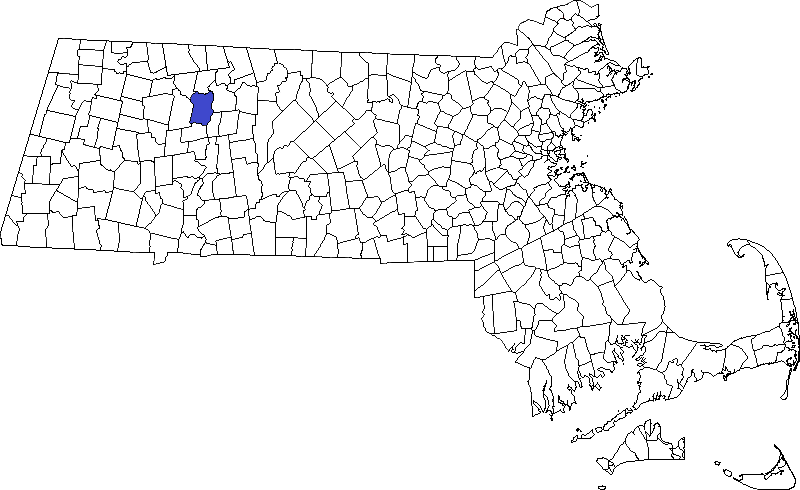
 Location: 60 Old Main Street, Deerfield
Location: 60 Old Main Street, Deerfield
Coordinates: 42°32’43.9″N 72°36’17.4″W
Date dedicated: September 4, 1867
Architect/contractor/sculptor: Carl Conrads, sculptor; James G. Batterson, New England Granite works, design and construction
Number of names: 42 who died in the war
The monument at Deerfield has the distinction of being the first in the Commonwealth to depict a Union soldier. This is no small claim. The “standing soldier” form seen on so many Civil War monuments has long been acknowledged as a important cultural development–an attempt to represent the Common Soldier rather than the Great General astride his horse (as seen in so many European monuments). This new American trend was democratic in philosophy, literally elevating the soldier in the eyes of the public, making him the symbol of reverence and creating a stand-in for so many husbands and sons lost.
Two Bay State monuments have been singled out as leading this artistic movement in Massachusetts. Deerfield’s by Carl Conrads and Roxbury’s by Martin Milmore were both sculpted in 1867 and both were pioneers (not just in Massachusetts but among the first in the nation). While Roxbury’s bronze “Citizen Soldier” was being cast, Deerfield’s was ready for dedication. So while they were nearly simultaneous in production, Deerfield’s was in place first.[1]
Carl Conrads, a German immigrant and Civil War veteran, was the leading sculptor for the Batterson Monumental Works in Hartford, Connecticut (later re-organized as the New England Granite Works and run by architect and sculptor James G. Batterson). Conrads was responsible for numerous well-known statues. His most prominent is the colossal “American Volunteer,” sculpted for the Antietam National Cemetery. The statue (21 feet high, not including the pedestal) was first exhibited at the 1876 Centennial Exhibition in Philadelphia, then moved to the Maryland battlefield cemetery. Conrads’s “American Volunteer” was reproduced in smaller form for several communities across the North including a few in Massachusetts–Lexington, Billerica, and Braintree among them.
 But Deerfield’s statue is not a version of Conrads’s “American Volunteer.” The Deerfield statue represents an earlier take on the Union soldier by Conrads. One can see similar elements in both iterations but Deerfield’s soldier seems to have a greater air of wisdom and melancholy. The long beard, reminiscent of Renaissance statues, gives the appearance of age. The great coat is not actually worn but draped loosely over his shoulders like a flowing toga or cloak. He is more introspective, with his downcast gaze, than the “American Volunteer,” who looks keenly to the distance. It is a splendid statue. And it was popular. Deerfield’s was first but it was reproduced in several locations including East Bloomfield, NY, Granby, CT, and Woonsocket, RI. All these were well before the “standing soldier” became commonplace about 10 years later.
But Deerfield’s statue is not a version of Conrads’s “American Volunteer.” The Deerfield statue represents an earlier take on the Union soldier by Conrads. One can see similar elements in both iterations but Deerfield’s soldier seems to have a greater air of wisdom and melancholy. The long beard, reminiscent of Renaissance statues, gives the appearance of age. The great coat is not actually worn but draped loosely over his shoulders like a flowing toga or cloak. He is more introspective, with his downcast gaze, than the “American Volunteer,” who looks keenly to the distance. It is a splendid statue. And it was popular. Deerfield’s was first but it was reproduced in several locations including East Bloomfield, NY, Granby, CT, and Woonsocket, RI. All these were well before the “standing soldier” became commonplace about 10 years later.
The Deerfield monument has undergone a remarkable transformation over the past several years. As mentioned, the original statue was sandstone. In 2013, an effort to restore the monument got underway and it was discovered that the stone statue was so seriously cracked that eventual collapse was almost inevitable. The estimated cost of repair would have been exorbitant. So, various organizations partnered to undertake the replacement of the statue–this time in more durable bronze. The new statue was hoisted into place in 2019.[2]
It was originally dedicated on September 4, 1867. The procession included some 30 veterans of the War of 1812. Henry L. Dawes, a Congressman from Pittsfield and a graduate of Deerfield Academy, gave the oration. According to one report, his reflections on the war dwelled on “the rebel cruelties inflicted on our soldiers…the treacheries and murders that culminated in the death of Lincoln, till the end came, but not till one great end, the abolition of slavery, was reached…”[3] The war was still raw in the memories of the speaker and his audience. As was the significance of abolition. In later dedications, other speakers would gloss over such notions, but the strong notes of sectionalism ringing in Dawes’s address just two years after the war are noteworthy.
Deerfield men served in numerous regiments during the war, however the two largest groups were 17 volunteers who signed up with the 21st Massachusetts Infantry and about 20 who served in the 34th Massachusetts.
Click to enlarge images:
[1] Boston Herald, August 21, 1867, 4. The brief article notes that the plaster cast for the Roxbury monument was to be sent that day to be cast. Deerfield’s finished monument was dedicated two weeks later.
[2] David McLellan, “From stone to bronze: New life for a Civil War soldier,” Daily Hampshire Gazette, June 11, 2019.
[3] Springfield Republican, September 5, 1867, 2.




